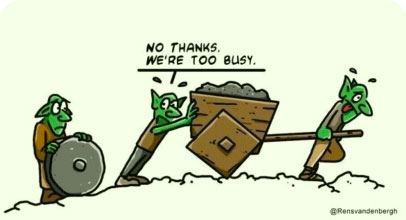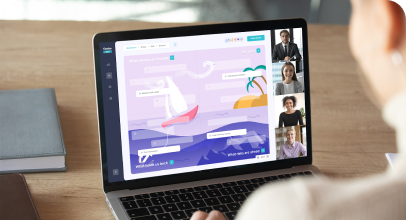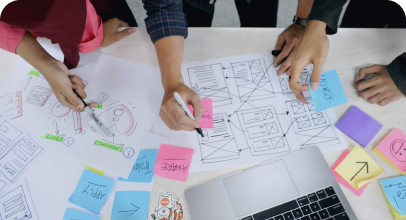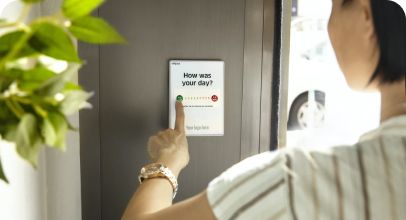
4Ls is one of the techniques that help your team look at the previous sprint from a different angle. It will encourage your teammates to take a break and think of what they personally gained or missed from the previous sprint. What is it I liked and learned? What I think the sprint was lacking and what did I longed for?
What is the exercise about and when to use it?
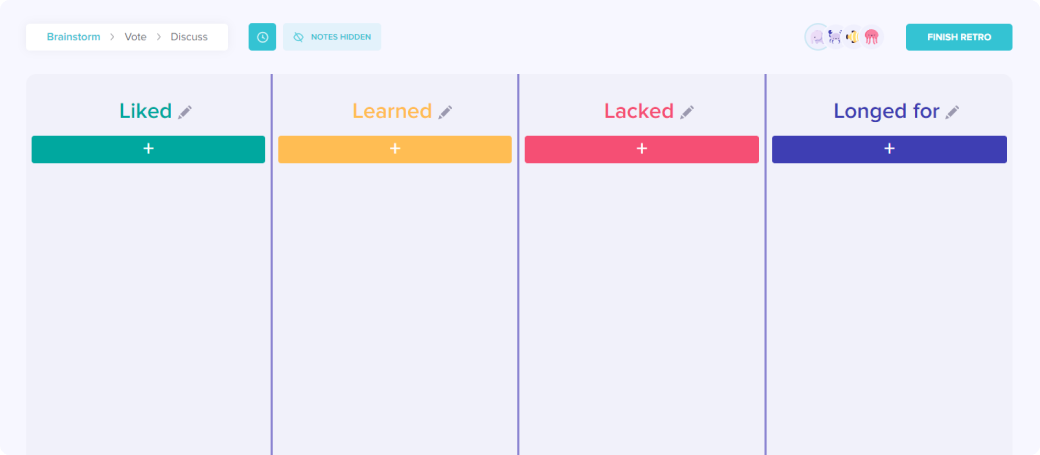
The 4Ls template is different from the 3 standard columns that people usually use on retrospectives. 4Ls has four columns that help people to answer the following 4 ‘L’ questions:
- What did I LIKE about the previous sprint?
- What did I LEARNED in the past iteration?
- What do I think the sprint LACKED?
- What is it that I LONGED for in the previous iteration?
This approach involves expressing more of the personal attitude during the discussion, rather than generalising the ideas in a standard 3 questions exercise. 4Ls exercise suits any team and helps to diversify the retrospective, especially when the team doesn’t generate a lot of insights within the standard approach. It will help to increase engagement and build trust inside the team. We also advise you to select this template after an especially difficult sprint.
How to run the 4Ls based retrospective?
1. Set up the scenes — your retrospective should be a safe place
Creating the atmosphere is one of the most important and both difficult parts of the retrospective preparation. Timbo suggests helping with this step by nice and effective icebreakers that create a trustful and cosy atmosphere. Select one of them that suits your team the most.
Make sure no one is distracted. Ask your teammates to turn off any notifications on their devices so that they could focus on feeling out the latest sprint. For a 4Ls exercise consciousness is a key to get truly insightful ideas, and it is really hard to reflect consciously if you’re getting distracted by the phones or other devices.
Timbo is a tool that promotes a sincere and trusting atmosphere in Agile meetings. Your teammates don’t need to sign up to participate in retro, or even reveal their names. They can join the meeting you created for them freely and anonymously.
2. Explain the purpose of the retrospective and encourage people to talk
It is highly important to make sure the team understands why they are doing a retrospective. You can remind them of Agile principles as well as the typical goal of any retro — to improve the process and make the team’s life easier. The more sincere ideas shared, the more effective process improvements are suggested. In the meantime, your teammates should understand that their opinions are heard and valued here. Encourage people to talk by defining that there is no right or wrong answer and any idea is important.
Describe the exercise, and what is required from the team to do. The effectiveness of the retrospective also relies on people’s participation and engagement, and if they don’t understand how to work with this particular template, what are the rules and conditions, then the engagement will fall down dramatically.
Tips:
- You can choose to hide teammates stickers from each other, which can possibly provide plenty of honest feedback. Or you can leave them visible if that is how the team prefers to work.
- In order to give people enough time to reflect and still keep within the time-box of the retro, set a time limit using TImbo timer feature.
3. Generate insights during brainstorming stage
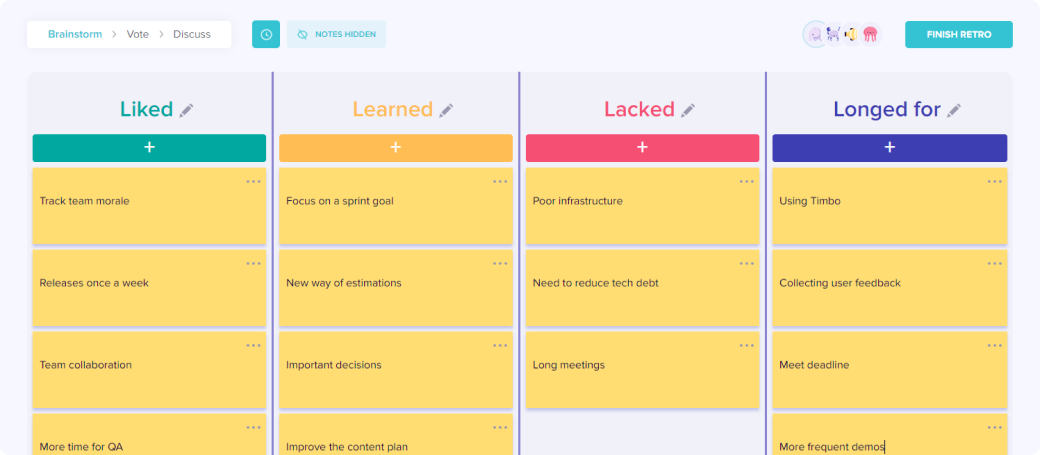
On the very first stage of the 4Ls exercise, ask your teammates to add the stickers with their ideas in each of the columns according to their meaning. Below is a helpful description of a guided facilitation process on how to conduct this exercise in Timbo effectively.
- collect the things that people liked about the last sprint
The goal in discussing what people like consists of two points. Firstly, it sets up the positive talk at the beginning so that people feel even more confident. Secondly — and most importantly — it also uncovers the underlying reasons for why a particular thing was liked. It will help gather things that create an ideal sprint for the team. - share what was learned in the past weeks
Any lesson learned during the completion of the actual tasks is valuable, whether it came from a specific challenge overcoming or regular investigations and brainstorms. Unfortunately, these lessons are not always shared with the team. This missed opportunity is what the 4Ls exercise successfully covers. Make sure the team understands that there are no small or insignificant lessons — every win should be known. - uncover what the team lacked of in the sprint
At the ‘Lacked’ column you collect the things that could make the iteration better, but they were not involved. This is a very important and difficult question that requires courage from the team. It’s possible that people might hesitate about answering that, as sharing what was lacking might offend someone, or maybe they are afraid of the top manager's reaction. However, if you manage to build a trustful and safe atmosphere, they will feel pretty comfortable at this point. Once you see the honest answers, you will be able to propose solutions on how to avoid similar problems in future sprints. Again — both trivial and complex ‘lacked items’ are important. - define what people longed for in the latest iteration
The last question focuses on the team's wishes and desires. It can be similar to the previous question, but it helps you to evaluate what is needed based on the positive impact it may have. This can include anything from ‘better internet’ till ‘more stakeholders engagement’.
4. Voting and Discussion stages
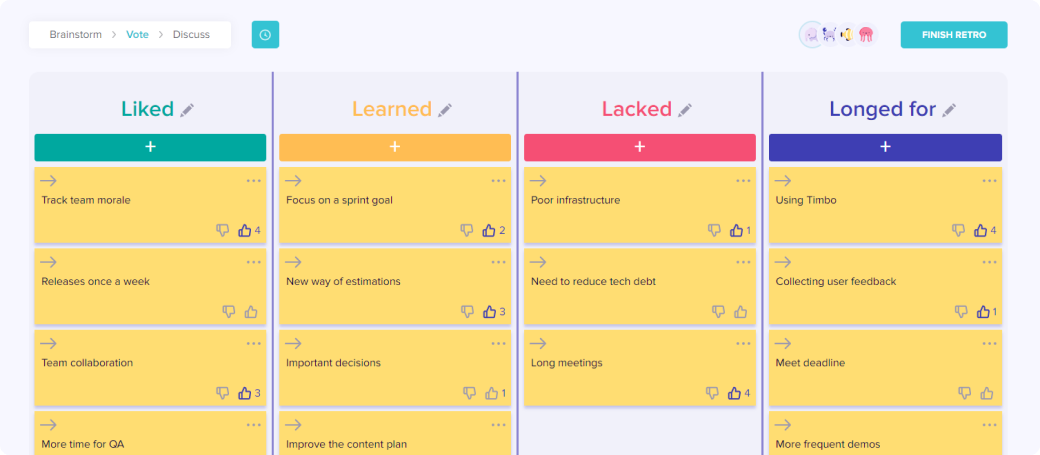
Now when the brainstorming step is finished, you can dedicate some time to voting for the most insightful or burning ideas. Let everyone in the team give their votes and discuss which of the stickers should drive points for improvement creation.
5. Don’t forget Action points!
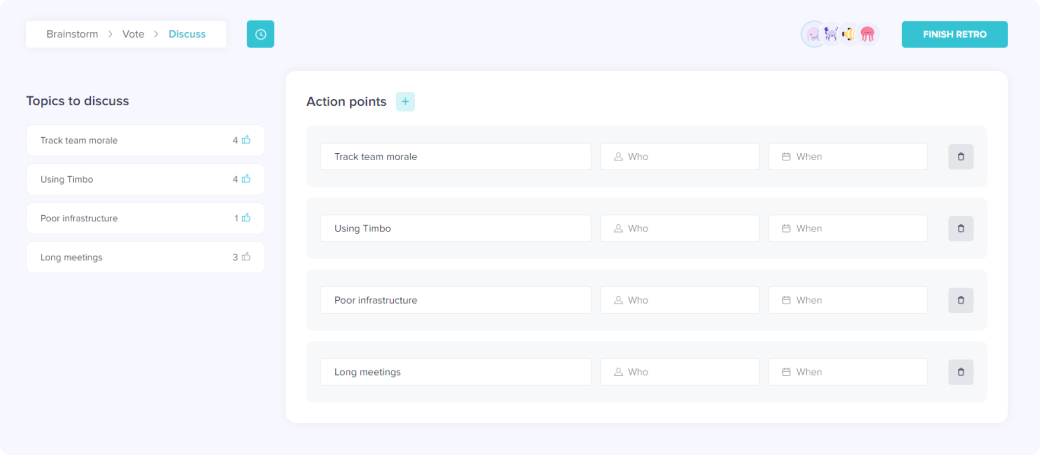
It is always helpful to process the emotions and personal feelings during the retrospective but don’t forget that the main focus should be on generating the Action Points from the ideas expressed. Mark the stickers that require action — they will be transferred to the Discussion stage automatically. At this stage you can add some details and comments to the Action Points if required. If you have your integration with Jira set up in your profile, your Action Points can be added to your project backlog automatically.
Be careful as this step is a key for the success of any retro, as if the Action Points are not created then the team will not see any improvements and will participate in future retrospectives less willingly.
6. Close the retrospective on a positive note.
Finish your retrospective with one of our closing activities so that everyone receives a positive vibe from the meeting. Even if the main stage was hard, something nice and heart-warming, like ‘Thank you cards’ will make everyone smile when leaving retro!
Timbo: designed by Scrum Masters for Scrum Masters
 Nadzeya Rynkevich
Nadzeya Rynkevich



